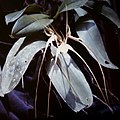Brassia
| Brassia subsp. var. | ||||||||||||||||||||||||||||||||||||||||||||||||||||||||
|---|---|---|---|---|---|---|---|---|---|---|---|---|---|---|---|---|---|---|---|---|---|---|---|---|---|---|---|---|---|---|---|---|---|---|---|---|---|---|---|---|---|---|---|---|---|---|---|---|---|---|---|---|---|---|---|---|

|
|
| ||||||||||||||||||||||||||||||||||||||||||||||||||||||
| ||||||||||||||||||||||||||||||||||||||||||||||||||||||||
Brassia is a genus of orchids classified in the Oncidiinae subtribe. The genus was named after William Brass, a British botanist and illustrator, who collected plants in Africa under the supervision of Sir Joseph Banks. Its abbreviation in the horticultural trade is Brs.
Brassia species and its popular hybrids are common in cultivation, and are notable for the characteristic long and spreading tepals (in some clones longer than 50 cm), which lend them the common name "spider orchid".
This epiphytic genus occurs in South Florida, the West-Indies and tropical America, in wet forests from sea level to altitudes under 1500 m, with the Peruvian Andes as its center. Occurrence is mostly restricted to a certain area, but Brassia caudata can be found over the whole geographic area.
They have large elliptic-oblong pseudobulbs with one or two leaves at the apex, lateral, unbranched many-flowered inflorescences with small floral bracts. The lip is not attached to the column. The pollinarium shows a narrow stipe. There are two distichous, foliaceous sheaths around the base, from which the inflorescence emerges.
Brassia has a very specific method for pollination : it uses entomophily : pollination by insects and in this case specifically by female spider-hunter wasps of the genera Pepsis and Campsomeris. Mistaken by the mimicry of Brassia, the wasp stings the lip, while trying to grasp its prey without any success. By these movements the wasp comes into contact with the pollinarium, that then sticks to its head. By flying to another Brassia flower, this flower gets pollinated.
| Standard Cyclopedia of Horticulture |
|---|
|
Brassia (named in honor of William Brass, a botanical collector of the last century). Orchidaceae. Epiphytic orchids, thriving in intermediate temperatures. Pseudobulbs bearing 1 or 2 terminal Lvs., and lateral or axillary racemes: sepals narrow, acuminate, or sometimes tailed, spreading, equal or the lateral longer; petals similar to the dorsal sepal or smaller; lip sessile on the foot of the column, spreading, flat, entire, shorter than the sepals; pollinia 2, waxy.—A genus of about 30 species extending from Mex. to Brazil and the W. Indies. The brassias are plants of easy culture and add considerable interest to collections. They have little value as a florists' flower since the colors are not suitable, but a well-grown specimen, such as is often seen in old gardens, makes a most attractive object. The long-tailed sepals and petals are a characteristic of the brassias, and some have an agreeable odor. Pot culture is best, with the usual peat fiber as a rooting medium. In winter-time much less water is necessary than in the growing time, although the plants must never be dried off completely or the flowering will be interfered with. One often sees plants of B. maculata brought here by visitors to Jamaica, and other species are now introduced there from the mainland of South America, and thrive well. These may all be grown in an ordinary greenhouse with other plants, in fact a mixed collection, and give satisfaction. Propagation is effected by division only. Green-fly is often troublesome on the young flower-spikes and must be kept down by fumigation, or sponge dipped in soapy water. B. Forgetiana. Hort. Fls. whitish with chocolate markings, the crest of the lip orange. Related to B. maculata.—B. Josstiana, Reichb. f. Brazil.
|
Cultivation
Propagation
Pests and diseases
Varieties
List of species:
- Brassia angustilabia
- Brassia antherotes
- Brassia arachnoidea
- Brassia arcuigera - Arching Brassia
- Brassia aurorae - Reddish Brassia
- Brassia bidens - Two-toothed Brassia
- Brassia boliviensis
- Brassia caudata - Tailed Brassia
- Brassia cauliformis
- Brassia chloroleuca - Green-and-white Brassia
- Brassia cochleata
- Brassia cyrtopetala
- Brassia filomenoi
- Brassia gireoudiana - Gireoud's Brassia
- Brassia helenae
- Brassia huebneri
- Brassia iguapoana
- Brassia jipijapensis - Jipijapa Brassia
- Brassia josstiana
- Brassia koehlerorum - Koehler's Brassia
- Brassia lanceana - Lance's Brassia
- Brassia maculata - Spotted Brassia
- Brassia neglecta - Overlooked Brassia
- Brassia pascoensis
- Brassia peruviana - Peru Brassia
- Brassia rhizomatosa
- Brassia signata - Marked Brassia
- Brassia suavissima
- Brassia thyrsodes
- Brassia transamazonica
- Brassia verrucosa - Warty Brassia
- Brassia villosa
- Brassia wageneri - Wagener's Brassia
- Brassia warszewiczii - Warscewicz's Brassia
Intergeneric hybrids:
- ×Alexanderara (Brassia x Cochlioda x Odontoglossum x Oncidium)
- ×Aliceara (Brassia x Miltonia x Oncidium)
- ×Bakerara (Brassia x Miltonia x Odontoglossum x Oncidium)
- ×Banfieldara (Ada x Brassia x Odontoglossum )
- ×Beallara (Brassia x Cochlioda x Miltonia x Odontoglossum )
- ×Brapasia (Aspasia x Brassia)
- ×Brassada (Ada x Brassia)
- ×Brassidium (Brassia x Oncidium)
- ×Brassioda (Brassia x Cochlioda)
- ×Brassochilus (Brassia x Leochilus)
- ×Brilliandeara (Aspasia x Brassia x Cochlioda x Miltonia x Odontoglossum x Oncidium)
- ×Crawshayara (Aspasia x Brassia x Miltonia x Oncidium)
- ×Degarmoara (Brassia x Miltonia x Odontoglossum )
- ×Derosaara (Aspasia x Brassia x Miltonia x Odontoglossum )
- ×Duggerara (Ada x Brassia x Miltonia)
- ×Eliara (Brassia x Oncidium x Rodriguezia)[1]
- ×Forgetara (Aspasia x Brassia x Miltonia)
- ×Goodaleara (Brassia x Cochlioda x Miltonia x Odontoglossum x Oncidium)
- ×Hamiltonara (Ada x Brassia x Cochlioda x Odontoglossum )
- ×Johnkellyara (Brassia x Leochilus x Oncidium x Rodriguezia)
- ×Maclellanara (Brassia x Odontoglossum x Oncidium)
- ×Miltassia (Brassia x Miltonia)
- ×Norwoodara (Brassia x Miltonia x Oncidium x Rodriguezia)
- ×Odontobrassia (Brassia x Odontoglossum)
- ×Pettitara (Ada x Brassia x Oncidium)
- ×Roccaforteara (Aspasia x Brassia x Cochlioda x Odontoglossum)
- ×Rodrassia (Brassia x Rodriguezia)
- ×Rohriara (Ada x Aspasia x Brassia)
- ×Sanderara (Brassia x Cochlioda x Odontoglossum)
- ×Sauledaara (Aspasia x Brassia x Miltonia x Oncidium x Rodriguezia)
- ×Schafferara (Aspasia x Brassia x Cochlioda x Miltonia x Odontoglossum)
- ×Shiveara (Aspasia x Brassia x Odontoglossum x Oncidium)
- ×Wingfieldara (Aspasia x Brassia x Odontoglossum)
Gallery
References
- Standard Cyclopedia of Horticulture, by L. H. Bailey, MacMillan Co., 1963



